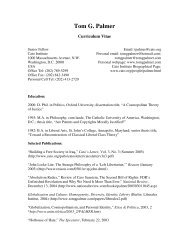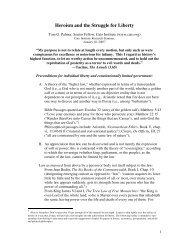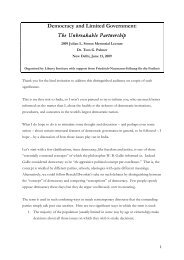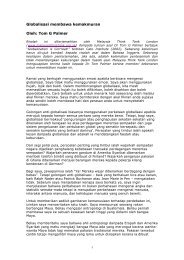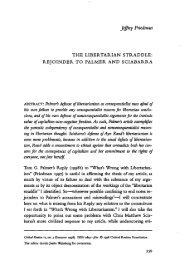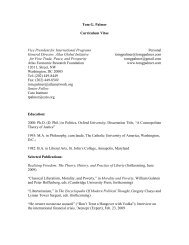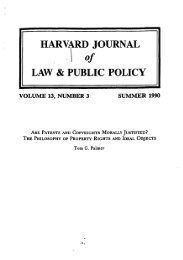G. A. Cohen on Self-Ownership, Property, and ... - Tom G. Palmer
G. A. Cohen on Self-Ownership, Property, and ... - Tom G. Palmer
G. A. Cohen on Self-Ownership, Property, and ... - Tom G. Palmer
Create successful ePaper yourself
Turn your PDF publications into a flip-book with our unique Google optimized e-Paper software.
<strong>Palmer</strong> - <str<strong>on</strong>g>Cohen</str<strong>on</strong>g> <strong>on</strong> <strong>Property</strong> <strong>and</strong> Equality 233what <str<strong>on</strong>g>Cohen</str<strong>on</strong>g> is c<strong>on</strong>cerned to show is that unequal marginal productivity,under such c<strong>on</strong>diti<strong>on</strong>s, will not result in an unequal distributi<strong>on</strong>of the joint product.) <str<strong>on</strong>g>Cohen</str<strong>on</strong>g> assumes, like Rawls, that all incomeis jointly produced <strong>and</strong> that the distributi<strong>on</strong> of the joint product is tobe the result of some sort of agreement am<strong>on</strong>g the joint owners.Where <str<strong>on</strong>g>Cohen</str<strong>on</strong>g> differs fiom Rawls is in granting, for ihe sake of his attemptedrefutati<strong>on</strong> of Nozick, that the parties to the agreement knowwhat their productive abilities are <strong>and</strong> have property in those naturaltalents. Joint ownership of external resources means that each ownerhas a full veto right over any proposed distributi<strong>on</strong> of the joint product,because each has a veto right over the dispositi<strong>on</strong> of the factorinputs, other than labor, that c<strong>on</strong>tribute to the producti<strong>on</strong> of the jointproduct. Thus, <str<strong>on</strong>g>Cohen</str<strong>on</strong>g> writes that “I entertained an alternative toNozick’s ‘up for grabs’ hypothesis about the external world, to wit,that it is jointly owned by every<strong>on</strong>e, with each having a veto over itsprospective use. And I showed that final equality of c<strong>on</strong>diti<strong>on</strong> is assuredwhen that egalitarian hypothesis about ownership of externalresources is c<strong>on</strong>joined with the thesis of self-ownership” (14). Carehlexaminati<strong>on</strong> dem<strong>on</strong>strates, however, that <str<strong>on</strong>g>Cohen</str<strong>on</strong>g>’s arguments do notshow that “final equality of c<strong>on</strong>diti<strong>on</strong> is assured!’Cohet) (1995, 94) proposes that we c<strong>on</strong>sider a two-pers<strong>on</strong> world,populated by “Able” <strong>and</strong> ‘‘hfirrn,” in which there is an asymmetry inthe productive capabilities of the. two parties, who are jointly owners ofall available external resources. In this situati<strong>on</strong>, “Each owns himself <strong>and</strong>both jointly own everything else.” <str<strong>on</strong>g>Cohen</str<strong>on</strong>g> (ibid., 95) then describesbetween the two parties is impossible:I three cases in which b.ar@g.i. Able cannot pmduce.per day what% needed for <strong>on</strong>e pers<strong>on</strong> for aday, so Able <strong>and</strong> Infirm both die.ii. Able can produce enough or more than enough for <strong>on</strong>e pers<strong>on</strong>, butnot enough for two, Infirm lets Able produce what he can, since <strong>on</strong>lyspite or envy would lead him nor to. Able lives <strong>and</strong> Infirm dies.iii. Able can produce just enough to sustain both himself <strong>and</strong> Infirm.So Infirm forbids him to produce unless he produces that much. Ablec<strong>on</strong>sequently does, <strong>and</strong> both live at subsistence.In these three cases there is no surplus over which to bargain. Thetwo cases in which bargaining over a surplus might take place are describedas follows:



